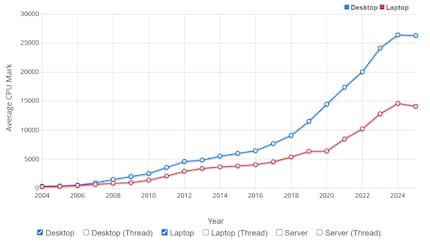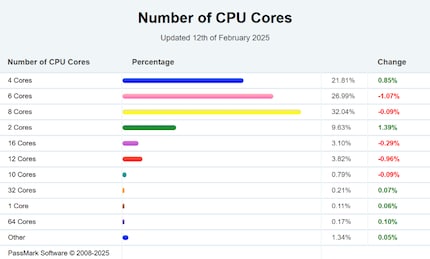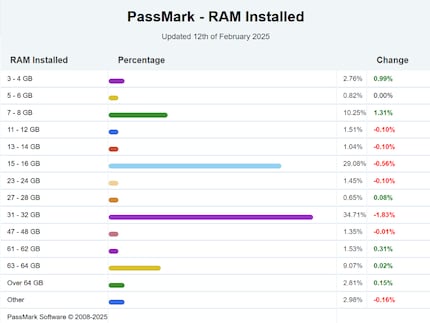
CPU performance drops in Passmark for the first time in 21 years
Benchmark software developer Passmark publishes the average results of Windows PCs worldwide in a line chart every fortnight. Until now, the curve has always pointed upwards. Now, for the first time since 2004, the opposite is the case.
For notebook CPU performance, Passmark registers a decline of 3.4 per cent compared to 2024. For desktop CPUs, the decline is smaller at 0.5 per cent, but it is still the first decline in the 21-year history.

Source: Passmark
Data basis seems solid
Even in the young year 2025, there is no lack of results. For notebooks, for example, the average of 25,541 results is 14,130 points. The average of 14,632 points from the previous year comes from 101,316 results. The situation is similar for desktop CPUs. The samples for 2025 are therefore already large enough to estimate a trend that is unlikely to change much this year due to fewer new CPU releases.
A falsification due to old PCs is ruled out, by the way. For a valid result, the CPU must be from at least 2009, support DirectX 9 and have 4 gigabytes of RAM.
What could be the reason for the decline?
On the one hand, the decline is probably due to a performance plateau that CPUs have now reached. There have been no major leaps in terms of cores and performance in the last two years, which is also reflected in the line chart.

Source: Passmark
On the other hand, the trends in purchasing behaviour with regard to CPU cores and memory indicate a decline. Fewer processors with 6 to 16 cores were tested, but more with 2 to 4. In terms of RAM, there was also an increase in systems with 8 gigabytes compared to those with 16 or 32 gigabytes.

Source: Passmark
The trend towards economical notebooks is also likely to have contributed to the decline. The performance increase here is also low. Passmark itself also suspects bloatware or the switch by many from Windows 10 to Windows 11.
However, the main reason is probably effectively the trend towards cheaper computers, which can be seen in notebooks and desktop PCs.
From big data to big brother, Cyborgs to Sci-Fi. All aspects of technology and society fascinate me.
From the latest iPhone to the return of 80s fashion. The editorial team will help you make sense of it all.
Show all